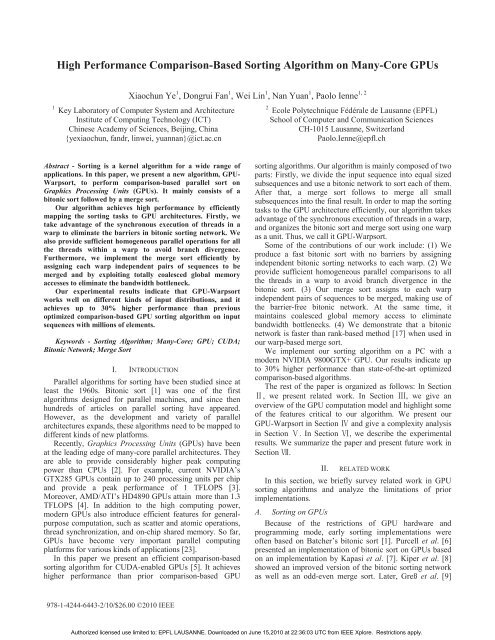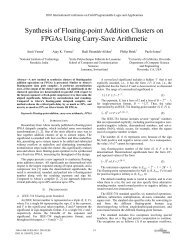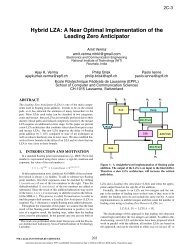High Performance Comparison-Based Sorting Algorithm ... - CiteSeerX
High Performance Comparison-Based Sorting Algorithm ... - CiteSeerX
High Performance Comparison-Based Sorting Algorithm ... - CiteSeerX
You also want an ePaper? Increase the reach of your titles
YUMPU automatically turns print PDFs into web optimized ePapers that Google loves.
<strong>High</strong> <strong>Performance</strong> <strong>Comparison</strong>-<strong>Based</strong> <strong>Sorting</strong> <strong>Algorithm</strong> on Many-Core GPUsXiaochun Ye 1 , Dongrui Fan 1 , Wei Lin 1 , Nan Yuan 1 , Paolo Ienne 1, 21Key Laboratory of Computer System and ArchitectureInstitute of Computing Technology (ICT)Chinese Academy of Sciences, Beijing, China{yexiaochun, fandr, linwei, yuannan}@ict.ac.cn2 Ecole Polytechnique Fédérale de Lausanne (EPFL)School of Computer and Communication SciencesCH-1015 Lausanne, SwitzerlandPaolo.Ienne@epfl.chAbstract - <strong>Sorting</strong> is a kernel algorithm for a wide range ofapplications. In this paper, we present a new algorithm, GPU-Warpsort, to perform comparison-based parallel sort onGraphics Processing Units (GPUs). It mainly consists of abitonic sort followed by a merge sort.Our algorithm achieves high performance by efficientlymapping the sorting tasks to GPU architectures. Firstly, wetake advantage of the synchronous execution of threads in awarp to eliminate the barriers in bitonic sorting network. Wealso provide sufficient homogeneous parallel operations for allthe threads within a warp to avoid branch divergence.Furthermore, we implement the merge sort efficiently byassigning each warp independent pairs of sequences to bemerged and by exploiting totally coalesced global memoryaccesses to eliminate the bandwidth bottleneck.Our experimental results indicate that GPU-Warpsortworks well on different kinds of input distributions, and itachieves up to 30% higher performance than previousoptimized comparison-based GPU sorting algorithm on inputsequences with millions of elements.Keywords - <strong>Sorting</strong> <strong>Algorithm</strong>; Many-Core; GPU; CUDA;Bitonic Network; Merge SortI. INTRODUCTIONParallel algorithms for sorting have been studied since atleast the 1960s. Bitonic sort [1] was one of the firstalgorithms designed for parallel machines, and since thenhundreds of articles on parallel sorting have appeared.However, as the development and variety of parallelarchitectures expands, these algorithms need to be mapped todifferent kinds of new platforms.Recently, Graphics Processing Units (GPUs) have beenat the leading edge of many-core parallel architectures. Theyare able to provide considerably higher peak computingpower than CPUs [2]. For example, current NVIDIA’sGTX285 GPUs contain up to 240 processing units per chipand provide a peak performance of 1 TFLOPS [3].Moreover, AMD/ATI’s HD4890 GPUs attain more than 1.3TFLOPS [4]. In addition to the high computing power,modern GPUs also introduce efficient features for generalpurposecomputation, such as scatter and atomic operations,thread synchronization, and on-chip shared memory. So far,GPUs have become very important parallel computingplatforms for various kinds of applications [23].In this paper we present an efficient comparison-basedsorting algorithm for CUDA-enabled GPUs [5]. It achieveshigher performance than prior comparison-based GPUsorting algorithms. Our algorithm is mainly composed of twoparts: Firstly, we divide the input sequence into equal sizedsubsequences and use a bitonic network to sort each of them.After that, a merge sort follows to merge all smallsubsequences into the final result. In order to map the sortingtasks to the GPU architecture efficiently, our algorithm takesadvantage of the synchronous execution of threads in a warp,and organizes the bitonic sort and merge sort using one warpas a unit. Thus, we call it GPU-Warpsort.Some of the contributions of our work include: (1) Weproduce a fast bitonic sort with no barriers by assigningindependent bitonic sorting networks to each warp. (2) Weprovide sufficient homogeneous parallel comparisons to allthe threads in a warp to avoid branch divergence in thebitonic sort. (3) Our merge sort assigns to each warpindependent pairs of sequences to be merged, making use ofthe barrier-free bitonic network. At the same time, itmaintains coalesced global memory access to eliminatebandwidth bottlenecks. (4) We demonstrate that a bitonicnetwork is faster than rank-based method [17] when used inour warp-based merge sort.We implement our sorting algorithm on a PC with amodern NVIDIA 9800GTX+ GPU. Our results indicate upto 30% higher performance than state-of-the-art optimizedcomparison-based algorithms.The rest of the paper is organized as follows: In Section, we present related work. In Section , we give anoverview of the GPU computation model and highlight someof the features critical to our algorithm. We present ourGPU-Warpsort in Section and give a complexity analysisin Section . In Section , we describe the experimentalresults. We summarize the paper and present future work inSection .II. RELATED WORKIn this section, we briefly survey related work in GPUsorting algorithms and analyze the limitations of priorimplementations.A. <strong>Sorting</strong> on GPUsBecause of the restrictions of GPU hardware andprogramming mode, early sorting implementations wereoften based on Batcher’s bitonic sort [1]. Purcell et al. [6]presented an implementation of bitonic sort on GPUs basedon an implementation by Kapasi et al. [7]. Kiper et al. [8]showed an improved version of the bitonic sorting networkas well as an odd-even merge sort. Later, Greß et al. [9]978-1-4244-6443-2/10/$26.00 ©2010 IEEEAuthorized licensed use limited to: EPFL LAUSANNE. Downloaded on June 15,2010 at 22:36:03 UTC from IEEE Xplore. Restrictions apply.
Sequence(global memory)d0 d1 d2 ... d29 d30 d31Sequenced0 d1 d2 ... d29 d30 d31Threadd31 d30 d29 ... d2 d1 d0Threadd0 d1 d2 ... d29 d30 d31Buffer(shared memory)d31 d30 d29 ... d2 d1 d0Bufferd31 d30 d29 ... d2 d1 d0(a) uncoalesced global memory access(b) coalesced global memory accessFigure 5. Global memory access patterns when fetching sequence elements.and t/2 elements from sequence B every time (t = 8 in Fig.4). Our bitonic network contains t elements and a t-elementbuffer in shared memory is allocated to store them. First, thewarp fetches the t/2 smallest elements from sequence A andthe t/2 smallest elements from sequence B, storing them intothe buffer. After a bitonic merge sort, the smallest t/2elements of the result are output, and the remaining t/2elements remain in the buffer. Next, the lower t/2 entries ofthe buffer are filled by new t/2 elements from sequence A orB depending on the result of comparing the maximumelements fetched last time. Assume a is the maximum ofmaxt/2 elements fetched from sequence A last time, and b maxisthe correspondence from B. If a ≤ b , the warp fetches tSequence ASequence Bbuf(shared memory)bufOutputbufbuf6 4 2 0maxmax0 2 4 6 8 10 12 141 3 5 7 9 11 13 151 3 5 7barrier-free bitonic merge network0 1 2 3 4 5 6 7Yes, then load the next4 elements from AA[3]
Input sequence... ... ... ... ... ... ... ... ... ... ... ... ... ...Sample sequence...sortSorted sample sequence... ... ... ... ... ... ... ... ...Splitters...Figure 7. Sample the input data to get the splitters. We sample the input sequence randomly to get k sample elements. Then we sort the samplesequence and construct the splitters by selecting every k-th element of the sorted sample sequence.C. Split into Small Tiles (Step 3)As we know, in merge sort, the number of pairs to bemerged will decrease geometrically. When there are notenough pairs of sequences to be merged, parallelism is lostand it is difficult to achieve high efficiency on massivelyparallel platforms such as many-core GPUs. As a result,large sequences have to be divided into smaller tiles oncethey are not able to provide sufficient parallelism.This operation is quite intuitive. Assume that we have lequal sequences of size n before the split operation, and eachsequence will be divided into s subsequences, as show inFig. 6. After splitting, all of the elements satisfy that thefollowing relation:∀a ∈subsequence( x, i), ∀b ∈subsequence( y, j): a ≤ b,where0 ≤ x < l,0 ≤ y < l,0 ≤ i < j < s.To maintain sufficient parallelism in step 2, l must belarger than the number of SMs. Our experiments show that64 is a good choice for 16-SM GPUs. Similarly, s must belarger than the number of SMs to provide high parallelismfor next step.In order to construct even splitters, we sample theoriginal input sequence randomly to get s*k sample elements.Then we sort the sample sequence and construct the splitters...Figure 6. Split each of the l large sequence into s small subsequences tomaintain sufficient parallelism.by selecting every k-th element of the sorted samplesequence, as shown in Fig. 7. Choosing a larger k consumesmore time, but produces better splitters. Note that thissample operation is performed before step 1.D. Final Merge Sort (Step 4)At the end of step 3, we have l large sequences and eachof them consists of s subsequences. To get the final sortedresult, subsequences (0,i), (1,i),…, (l-1,i) need to be mergedinto one sequence S i . It is obvious that S 0 , S 1 ,…, S l can bemerged independently, thus regenerating sufficientparallelism for many-core GPUs.Similar to the method used in step 2, each pair ofsubsequences is merged by a warp. Finally, S 0 , S 1 ,…, S l areassembled into a totally sorted array.Note that the start and end addresses of the subsequencesafter division may not be aligned. In order to avoiduncoalesced global memory access, we patch the start andend of each subsequence by inserting some special keys, ifthey are misaligned.V. COMPLEXITY ANALYSISOur sorting algorithm mainly consists of two parts:bitonic sort in step 1 and merge sort in the following steps.We can discuss the complexity of each part independentlyfirst. Then we will get the total complexity of our algorithm.A. Time ComplexityIn the bitonic sort of step 1, we assume the inputsequence contains n elements and each equal-sizedsubsequence has w elements. Then, the average time2complexity is O ( n(logw)) . Because w is a constant in ourimplementation, the time complexity of step 1 is O (n).As for the merge sort in the following steps, the mergetree contains log( n / w)levels. In each level, the bitonicsorting network consists of t elements. Thus, every elementneeds O ((log t)2 ) compare operations in each level, andAuthorized licensed use limited to: EPFL LAUSANNE. Downloaded on June 15,2010 at 22:36:03 UTC from IEEE Xplore. Restrictions apply.
Time (msec)450400350300250200150100500mergesort radixsort warpsort quicksortko kv ko kv ko kv ko kv ko kv1M 2M 4M 8M 16MSequence SizeFigure 8. Execution time comparison with other implementations.(ko: key-only; kv: key-value)<strong>Sorting</strong> Rate (millions/sec)706050403020100warpsortradixsortmergesort1M 2M 4M 8M 16MSequence SizeFigure 9. <strong>Sorting</strong> rate comparison with other GPU-based implementations.( key-value pairs)the time complexity of merge sort is2O ( n log( n / w)• (log t)) = O(n log n)As a result, the time complexity of our GPU-warpsort isO ( n)+ O(n log n)= O(n log n)B. Space ComplexityIn our algorithm, bitonic sort works in-place; thus, thereis no need to use auxiliary buffer in step 1. However, themerge sort does not work in-place: we use two buffers andswitch each other in different levels of the merge tree. Inaddition, we need a little more auxiliary space for thepatching of misaligned address. Thus the space requirementof our algorithm is 2n+c. The constant c depends on thenumber of splitters used in step 3.VI. EXPERIMENTAL RESULTS AND DISCUSSIONWe have implemented our GPU-Warpsort using theCUDA programming API. We study its performance on aPC with dual core AMD Opteron880 at 2.4 GHz, 2GB RAMand a NVIDIA 9800GTX+ with 512 MB of on boardGraphics RAM. The host is running Red Hat Linux. We testour implementation with key-only and key-valueconfigurations where both key and values are 32-bit words.A. <strong>Performance</strong> EvaluationWe compare the performance of GPU-Warpsort to stateof-the-artimplementations on GPUs. To be best of ourknowledge, Satish et al. [17] have implemented both thefastest published sorting algorithm and the fastestcomparison-based sorting algorithm for modern GPUprocessors so far. As a result, the algorithms that have beendemonstrated to be slower than Satish’s implementation arenot compared in this paper: this includes the radix sortpublished by Le Grand in GPU Gems 3 [15], the radix sortimplemented by Sengupta et al. [12], and the bitonic sortbased GPUSort of Govindaraju et al. [11]. In addition toSatish’s implementation, we also compare our algorithm totwo other comparison-based algorithms: the quick sortdesigned by Cederman et al. [18] and the bitonic sort ofBaraglia et al. [20]. We measure the GPU execution timeonly and do not include the data transfer time between thehost and GPU memory. The input arrays are randomlygenerated sequences whose lengths range from 1M elementsto 16M elements. Unless otherwise specified, we reportresults for sequences with uniform random distribution.Fig. 8 and Fig. 9 report the execution time and sortingrate of different algorithms on the 9800GTX+. Among thesealgorithms, GPU-Warpsort, quicksort and merge sort arecomparison-based. It is obviously that GPU-Warpsort issubstantially faster than quicksort. For key-only sequences,GPU-Warpsort achieves 1.7 times higher performance onaverage. Cederman et al. did not implement a key-valuevariant of their quicksort, but, according to Fig. 8, the resultof key-value warpsort is even faster than that of key-onlyquicksort. Therefore, we believe that our algorithm will alsobe much faster than quicksort for key-value sequences.When compared to the merge sort of Satish et al., which wasthe fastest comparison-based GPU sorting algorithm, GPU-Warpsort sports a performance over 20% higher on average;for sequences larger than 4M, GPU-Warpsort even achievesup to 30% higher performance.Time (msec)450400350300250200150100500Time_zero Time_uniform Time_gaussian Time_bucket Time_sortedRate_zero Rate_uniform Rate_gaussian Rate_bucket Rate_sorted701M 2M 4M 8M 16MSequence SizeFigure 10. Sort performance for different distributions.(key-value pairs)65605550454035<strong>Sorting</strong> Rate (millions/sec)Authorized licensed use limited to: EPFL LAUSANNE. Downloaded on June 15,2010 at 22:36:03 UTC from IEEE Xplore. Restrictions apply.
Time (msec)1009080706050403020100bitonic_warpbitonic_blockko kv ko kv ko kv ko kv ko kvTime (msec)400350300250200150100500coalesceduncoalescedko kv ko kv ko kv ko kv ko kv1M 2M 4M 8M 16MSequence Size1M 2M 4M 8M 16MSequence SizeFigure 11. <strong>Performance</strong> of bitonic sort in step 1Figure 12. <strong>Performance</strong> of merge sort in step 2(ko: key-only; kv: key-value)(ko: key-only; kv: key-value)300250bitonic_mergerank_mergeTime (ms) step1 step2 step3 step4 total400350Time (msec)200150100300250200150501000ko kv ko kv ko kv ko kv ko kv1M 2M 4M 8M 16MSequence SizeFigure 13. <strong>Performance</strong> of rank-merge and bitonic-merge(ko: key-only; kv: key-value)5001 2 3 4 5 6 7 8 9 10 11 12 13 14 15 16Sequence Size (Millions)Figure 14. Time taken by different steps(use key-value pairs, uniform distribution)Nevertheless, our results show that radix sort is still thefastest sorting algorithm on GPUs. Our key-only warpsort isonly as fast as the key-value radix sort in most cases and ourkey-value warpsort is about 40% slower. But radix sort is notcomparison-based, thus not as generic as ours.We could not find the source code available for thebitonic sort of Baraglia, but, according to their reportedresults, the performance of their bitonic sort is similar to thatof the quicksort designed by Cederman et al. [18]. ThusGPU-Warpsort should perform substantially better thanbitonic sort.We also tested our sort on different key distributions,including zero, sorted, uniform, bucket, and Gaussiandistributions (see Fig. 10). GPU-Warpsort shows about thesame performance on uniform, bucket, and Gaussiandistributions. Besides, applying it to zero distributionsequences does result in obviously shorter execution time.On average, it achieves 15% higher performance for keyonlysequences and 46% higher performance for key-valuesequences. This improved result can be mainly attributed tothree reasons: First, when sorting zero-distributed sequencewith a bitonic network, all the comparison operationsproduce false results and no swap operation is performed.Secondly, after the split operation in step 3, all largesequences will be divided into equal-sized subsequences.This produces a balanced task for each block or thread.Third, there is no necessity to patch the borders ofsubsequences in step 4, because zero-distributed sequencesare always split into aligned subsequences. We also note thatour algorithm becomes worse when the input sequence isalready sorted. This is mainly because of the load imbalanceoccurring in the last step. Our algorithm does not excel onnearly sorted sequences.Next, we evaluate the impact of warp-based bitonic sortand global memory access patterns. For comparison, weimplement a block-based bitonic sort in step 1 and a mergesort with uncoalesced global memory accesses in step 2. Theblock-based bitonic sort assigns t elements to a t-threadblock and uses barriers to synchronize with other threads.The merge sort is implemented according to Fig. 5(a). Figs.11 and 12 show the performance results. Because warpbasedbitonic avoids barrier operations and thread idling, itachieves 76% and 57% higher performance than block-basedbitonic sort for key-only and key-value input sequences,respectively. As for merge sort, the one with coalescedmemory accesses also shows an obvious advantage over thatwith uncoalesced accesses. According to Fig. 12, the formeris 74% and 94% faster than the latter for key-only and keyvaluesequences, respectively. Further analysis shows thatAuthorized licensed use limited to: EPFL LAUSANNE. Downloaded on June 15,2010 at 22:36:03 UTC from IEEE Xplore. Restrictions apply.
[13] M. Harris., S. Sengupta, J. D. Owens.: Parallel prefix sum (scan) withCUDA. In GPU Gems 3, Nguyen H., (Ed.). Addison Wesley, Aug.2007, ch. 31.[14] E. Sintorn and U. Assarsson. Fast parallel gpu-sorting using a hybridalgorithm. Journal of Parallel and Distributed Computing, 2008.[15] S. Le Grand, “Broad-phase collision detection with CUDA,” in GPUGems 3, H. Nguyen, Ed. Addison-Wesley Professional, Jul. 2007, ch.32, pp. 697–721.[16] B. He, N. K. Govindaraju, Q. Luo, and B. Smith, “Efficient gatherand scatter operations on graphics processors,” in Proc. ACM/IEEEConference on Supercomputing, 2007, pp. 1–12.[17] N. Satish, M. Harris, and M. Garland. Designing efficient sortingalgorithms for manycore GPUs. In IPDPS, 2009.[18] D. Cederman and P. Tsigas, “A practical quicksort algorithm forgraphics processors,” in Proc. 16th Annual European Symposium on<strong>Algorithm</strong>s (ESA 2008), Sep. 2008, pp. 246–258.[19] “NVIDIA CUDA SDK,” http://www.nvidia.com/cuda, 2009.[20] R. Baraglia, G. Capannini, F. M. Nardini, and F. Silvestri. <strong>Sorting</strong>using Bitonic Network with CUDA. In the 7th Workshop on Large-Scale Distributed Systems for Information Retrieval (LSDS-IR) ,Boston, USA, July, 2009.[21] E. Lindholm, J. Nickolls, S. Oberman, and J. Montrym, “NVIDIATesla: A unified graphics and computing architecture,” IEEE Micro,vol. 28, no. 2, pp. 39–55, Mar/Apr 2008.[22] S. Sengupta, M. Harris, and M. Garland. Efficient parallel scanalgorithms for GPUs. NVIDIA Technical Report NVR-2008-003,December 2008.[23] M. Garland, S. Le Grand, J. Nickolls, et al.. Parallel ComputingExperiences with CUDA,” IEEE Micro, vol. 28, no. 4, pp. 13–27,2008.[24] N. Satish, M. Harris, and M. Garland. Designing efficient sortingalgorithms for manycore GPUs. NVIDIA Technical Report NVR-2008-001, Sep. 2008.Authorized licensed use limited to: EPFL LAUSANNE. Downloaded on June 15,2010 at 22:36:03 UTC from IEEE Xplore. Restrictions apply.





